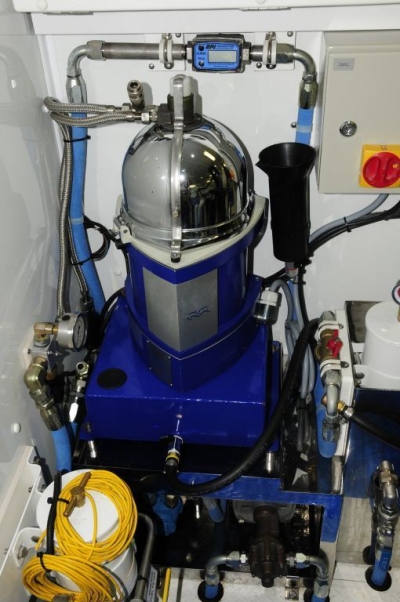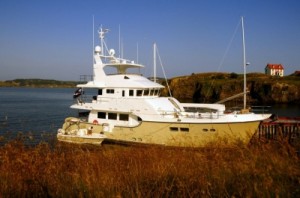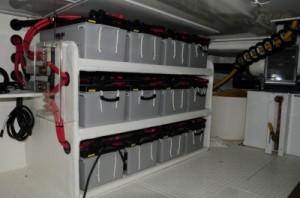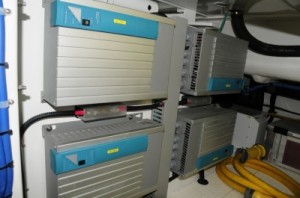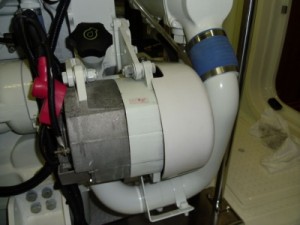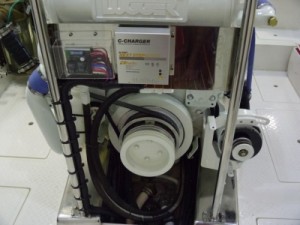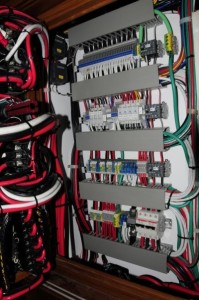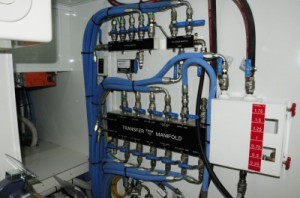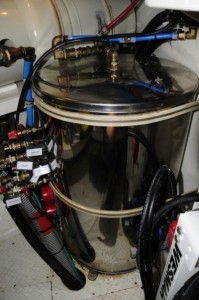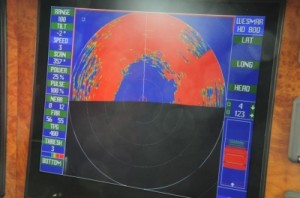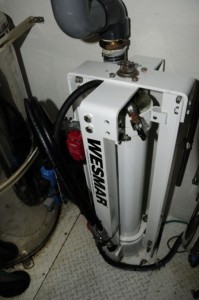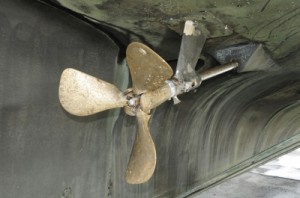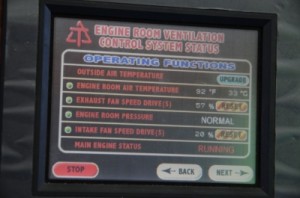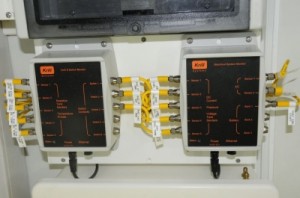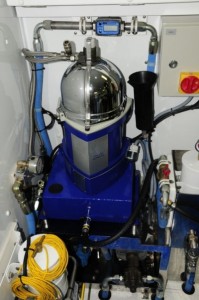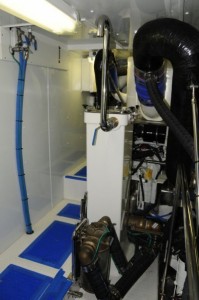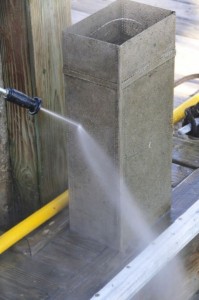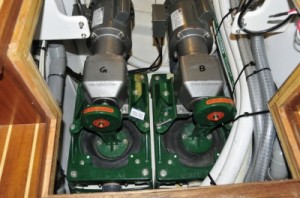The Trend Toward Complexity
A call to the marine industry to stop apologizing for it, and simply get on with making systems work reliably.
by Steve D’Antonio
photos by Steve D’Antonio
Modern cruising vessels have a variety of complex systems that afford users all the luxuries of home. Contrary to popular belief, there is no reason why these systems can’t be made reliable.
It’s a truism, vessels get more complex with each passing year, however, as an industry do we need to lament or apologize for that? I don’t believe so.
I’ve noticed a trend of late that is becoming fashionable with many industry journalists, pundits, and soothsayers and it’s trickling down to some would-be boat buyers as well; it involves adoption of the KISS or keep it simple principal. Perhaps adoption isn’t the right word; it’s more of a call for adopting this principal because boats are getting too complex and too expensive and that’s scaring away boat buyers and turning off boat owners.
While I applaud approaches that make boats and boating more affordable, more economical, and more efficient, I have to call a trickle down “feel good” statement, which in effect does little good, when I see it, and I believe the admonition for failing to KISS as just that, an effort to sound trendy and offer the appearance of doing something about the complexity, reliability and expense problems faced by many boat owners, builders and yards. In fact, while simplicity can be sublime in a variety of forms, I’m convinced that striving for simplicity, where marine systems are concerned, isn’t the panacea many believe it to be. Is it a noble effort? Perhaps, but one that is, I believe, misguided and one as a professional you shouldn’t fall for and one you shouldn’t let your customers fall for either because, ultimately, it’s one with which they will be dissatisfied. That’s not to say we, as an industry, aren’t facing a problem with reliability where many vessels are concerned, indeed, we are, however, don’t confuse this scenario with a need for a return to simplicity, it represents two steps backward and one forward.
Massive battery banks are becoming more prevalent and the wiring, circuit protection, and containment need to be up to the task.
A few months ago I completed an inspection aboard a recently finished cruising vessel belonging to one of my clients. Among other things, the 68-foot FRP expedition passage maker is equipped with a single main engine (that’s a type of simplicity I can embrace), a wing engine, twin generators (of different sizes), a 15 kW true sine wave inverter (yes, 15 kW, it can operate 50% of the vessel’s HVAC system while underway), quadruple HVAC chillers, a centrifugal fuel polishing system, an integrated vessel monitoring system, twin 1400 gpd water makers, hydraulic stabilizers, thrusters, crane and windlass, a retractable sonar, 12 and 25 kW radars, twin isolation and boosting transformers, a sea chest, etc. You get the point; this vessel is systems-intensive, some would say complex, – more on that in a moment – to cruise virtually anywhere in the world. That was the owner’s goal, as an experienced mariner and a full-time live-aboard; he wanted to be able to cruise far afield with as much autonomy as possible, while not sacrificing the comforts to which he and his wife had become accustomed in their daily life ashore.
Those “comforts” included, among others, toilets that flush reliably, along with a sanitation system that doesn’t smell, comfortable and efficient heating and air-conditioning, refrigerators and freezers, satellite television, and clean hot and cold running water of course. These systems have, for all intents and purposes, become de rigueur aboard even smaller, more modest vessels. The desire for more home-like comfort and amenities have in turn bred more complexity aboard today’s boats. That’s no sin, unless that complexity in turn breeds unreliability and excessive maintenance costs. Hold that thought.
Larger battery banks require larger charge sources that are capable of charging them in a reasonable time period.
Walking the Walk
As I write this column, this vessel is hauled for routine work in North Carolina after having completed a two-year long journey that took her from Florida and the Bahamas to Bermuda, Newport, Rhode Island, Halifax, Nova Scotia and on to a circumnavigate Newfoundland, where I joined her, down the East Coast and back to Florida, to the Bahamas again, Florida and then North Carolina, totaling about 10,000 miles and 1500 hours on the main engine, approximately 1800 hours on each of the two gensets, and 75 hours on the wing engine (the wing serves as a hydraulic pony engine, too.)
Power management, as well as generator usage, was of significant concern to the owner during the design phase. Toward that end, virtually every light aboard the vessel is LED, and it was the driving factor behind the large inverter system, which is designed to derive power from the main engine’s twin high-output alternators. During the design phase of this system, there were more than a few naysayers who believed an inverter of this size and a system of this complexity could not be made to work reliably. Many said “it’s been tried before, and it’s failed”. I don’t blame them for being skeptical, many such systems have failed. An electrical design engineer prepared the technical proposal, which was then reviewed by yet another electrical engineer. After a few changes, all parties ultimately agreed that it should work, although, as is often the case with a relatively uncommon system, there were no guarantees.
The twin, high-output alternators on the front of this engine had to be engineered for proper support and belt alignment. There is a limit to how much horsepower can be taken from the crankshaft and the loads also need to be balanced to keep bearing loads to a minimum.
The plan was then sent to two inverter manufacturers who both agreed their gear could deliver what was required. The one that was ultimately selected, Mastervolt, also agreed to inspect and approve the system as installed, to ensure it would be not only reliable, but warranted as well, a value added to be sure, considering the less-than-common installation arrangement. Interestingly, when presented with the finished design, the vessel’s builder refused to install the system. However, I believe that was a bold step and the right one; they weren’t prepared to own this design or installation, which wasn’t their own. I often counsel my clients on not pushing builders beyond their technical comfort level with untried or cutting edge systems, and I nearly as frequently counsel boat builders to avoid allowing themselves to be pushed beyond this point. In many cases, in an effort to please the customer, and/or to avoid losing the sale, they acquiesce to an installation that, in their boat builder’s heart or hearts, they are not fully comfortable with. In this case, this builder was confident in their abilities and what they were willing to take responsibility for, they knew when to say no and for that I commend them. To their credit, however, they did agree to pre-wire the vessel to ease installation of this system and reduce the cost of doing so. The components were installed after the vessel was completed.
The system was conservatively designed to operate one of the four chillers, to cool select portions of the vessel while underway. The vessel’s 1100 amp-hour, 24 volt battery bank will carry one chiller for about four hours, along with the vessel’s other loads. However, it was not designed to operate under these circumstances. It’s primary goal is to supply power for the HVAC system while under way and thereby reduce accrued generator run time and maintenance. In fact, in practice, it will run two chillers without difficulty.
Neatly laid out and well labeled and secured wiring and circuit protection may take longer to accomplish, however, it will pay dividends many times over during the life of the vessel. Finding faults (if there are any) or adding future systems will be more easily accomplished.
In August of 2011, I spent ten days aboard her as she cruised Newfoundland’s North Coast, getting a feel for how her web of systems operated and, more importantly, how functional and reliable they really were, from the retractable sonar transducer installed in the forward engineering space to the mother of all inverters in the lazarette.
My work and interaction with this client began before the vessel’s keel was laid and continues to this day. Over the course of the build, the owner and I poured over the vessel’s various systems specifications, CAD drawings and related documentation. Taken as a whole, the task was herculean. However, when spread over the course of the build’s eighteen months (the actual construction time for the yard was eleven months) it was more than manageable. Systems decisions included everything from domestic plumbing design (in addition to being heated electrically, should the water heater receive heat from the engine or one, or both of the generators and should such a system rely on a heat exchanger and circulation pump to minimize the risk of loss of coolant for the engine?) to engine room ventilation (should standard, generic intake and exhaust blowers be used, or should a more sophisticated, more complex, fully-engineered ventilation system that monitored and automatically acted on temperature input while maintaining pressure be employed?)
In every case, the pros and cons were weighed and evaluated. Evaluation criteria included the presumed benefit the design would offer – accessibility and serviceability (this was especially important because of the desire of the owner to do as much maintenance and repair himself, particularly while in remote locations), weighing that against added complexity and the increased potential for failure it might bring. Above all else, decisions took into account ensuring the greatest possible reliability, redundancy, ruggedness, safety-of-operation and yes, simplicity, when and where that feature made sense. Simplicity was never a goal unto itself.
Using this vessel’s manifold system, fuel can be taken from or directed to any source. Every valve is clearly labeled and documented. This approach affords the user a variety of options and work arounds in the event of a problem.
Complexity, Cost and Reliability
The primary complaint I hear from my clients isn’t predicated on the complexity of their vessels, in most cases their dissatisfaction revolves around systems that are unreliable or expensive to troubleshoot and repair or, they simply haven’t gotten what they’ve paid for. This is, I believe, the impetus for the keep it simple tag line. Thus, the call for simplicity, it’s not a trend because so few truly simple vessels are being built, is, in my opinion, a hollow one indeed. It is, instead, reactions to failures on what I believe are several fronts.
First, in the consulting and vessel inspection work I carry out, I encounter many vessels’ systems that were installed with a disparate rather than unified approach. Yet, the challenge resides, first, and without a doubt most importantly, in the design and integration of many of these seemingly complex onboard systems, on someone’s drawing board, desk or monitor rather than on the shop floor. This amounts to little more than the designer or installer doing his or her homework – efficiently utilizing space, fully absorbing manufacturers’ installation requirements, and carefully considering installations for the exceptionally important aspect of ease of access for service and repair. Systems-rich vessels that afford users and repair personnel poor access to critical components amount to little more than a delayed dirty trick perpetrated by the builder, or those installing gear, on the owner. If you have to remove two pieces of gear to get to another for repairs or routine service, someone hasn’t given the design enough thought, a practice for which there is little excuse.
This water heater utilizes multiple heat exchangers and multiple electric heating elements to heat water within its microbe resistant copper tank.
When systems are not planned and appropriately integrated, the realizations that owners often face are, they cannot carry out preventive maintenance because of poor access, the equipment fails, often after the warranty period because it was improperly installed, they can’t see problems developing because they’re hidden under layers of other equipment, and they’ve paid extra for something that fails prematurely. Think of the seacock that seizes, or fails all together, because it can’t be accessed for inspection, exercise or service. It’s up to the designer, builder and/or installer to be alert to these potential problems. They are not an issue whose genesis is over-complexity; instead, they are all too often rooted in poor design, poor installation technique, and a failure to integrate systems.
Regrettably, in many cases, there is little or no design per se, installation decisions are left to those on the shop floor, and no emphasis is placed on looking at the big picture and how many systems integrate with or affect each other. The piecemeal approach, almost inevitably leads to operational conflicts, unreliability, and excessive maintenance costs. Oh, and an unhappy customer who quickly loses faith in his or her vessel.
Avoiding such problems could be as simple as ensuring that the vacuum pump that’s been installed for the sanitation system doesn’t impede access to a seacock or washdown pump, or the air-conditioning compressor doesn’t impede access to the vacuum pump. There’s no doubt, taking such a planned, integrated approach requires a greater investment on the part of the designer or installer and perhaps added labor; however, it’s an investment that will pay dividends.
Not your average depth sounder, this retractable sonar is extremely accurate and takes much of the mystery of what lies ahead. In this case, it’s worth it; this particular vessel goes places where the charts may have last been sounded with a lead line, or not at all.
Adding insult to injury is the fact that the builder of the vessel or installer of the gear fails to provide the necessary documentation, schematics or instruction for the user. In such cases, when the gear doesn’t work as advertised, it’s all too easy for observers to proclaim the system as “too complicated”.
Simply put, inadequate forethought can lead to inability to reach an important piece of gear. In other cases, the problem is more insidious. Installation of a large bank of AGM batteries with a standard, off the shelf engine alternator, and a small, dockside maintenance battery charger will lead to chronically under-charged batteries and their premature and costly demise and/or poor performance, along with, again, the user’s deep dissatisfaction and loss of faith in the builder or installer. It’s not uncommon for someone to proclaim this poorly designed system too big, trying to do too much or, too complicated. In fact, electrical systems and charging and battery systems in particular, are a frequent source of frustration for vessel owners. It’s little wonder; too many builders and refit yards apply too little effort in designing an integrated system, one whose charge output appropriately matches the capacity of the house battery bank, along with providing the user a relatively easy way of monitoring use and rate of charge. In most cases, it simply and literally comes down to doing the math – what are the loads, how long will they operate for, what size battery bank does that require, and how much charge does it need for a reasonable recharge interval? They also fail to teach the owner how to operate it and ensure it’s properly maintained as well as supplying adequate documentation and schematics.
There are a lot of choices for propulsion on a cruising power boat and opinions abound about which is best. Single engine, twin engine, main engine with wing engine are just some of the choices. Whatever the choice, the systems must be correctly installed for maximum reliability and serviceability.
Second, subscribing to the axiom, “forget about support, if you build it, they will buy it”. Many equipment manufacturers/suppliers introduce products that, while often well designed, and made of high quality materials, are poorly supported. To be fair, many do so with enthusiasm, as well as the best of, albeit naïve, intentions. I’ve encountered this scenario on countless occasions, from stoves and anchors to battery chargers and engines.
When individuals or industry clients consult with me for my take on a new product they are considering using, or an idea they have to manufacture or distribute a product (in the latter case, it’s often a product from overseas, whose literature has been poorly translated, if at all, or relies on pictograms for complex tasks), my first refrain is often “how will you support it, what service literature will you provide, will literature and all service manuals be available on line, will you have a dealer network, will you have an expert on hand who knows the product thoroughly, will you be able to respond knowledgeably to e mail queries and phone calls requesting installation and troubleshooting support, etc, etc?”
Simply put, few things frustrate installers and vessel owners alike more than products that, regardless of how well they are made, are poorly supported. In many cases, the word gets out and these manufacturers or distributors aren’t around for very long. However, in the time they are around, they can wreak untold damage on vessel owner’s and boat builders’/yards’ wallets and patience as well as on the reputation of the marine industry in general. Every such shortcoming and every poorly supported product represents a further degradation in the reputation of the industry as a whole.
In the interest of ensuring reliability of any system, complex or otherwise, I strongly recommend that builders, yards and installers carefully consider the use of any product, particularly a new product, based not only on how well it may appear to do the job or fill a particular niche, but also on how well it is supported. On a related note, I’ve noticed a tendency among industry end users of equipment to use a new product because it’s new. When I managed a boat yard, I resisted this temptation. Just because it was new, it had a compelling ad, and my peers were using it, why should I do so as well? Be discerning – a manufacturer or distributor of a new product or one that is new to your region or country, should have to work to earn your trust. Make them detail for you the products advantages as well as the means of support.
Sophisticated systems merit sophisticated monitoring. Top, a Delta T engine room ventilation system touch screen control panel. Bottom, interface hubs for a Krill vessel monitoring system.
Great Expectations
Most boat owners I know aren’t willing to give up all or even some of the comforts of home, and in some cases more, when they go cruising, nor should they. While I personally don’t watch much TV, I recognize that many folks want to do just that while they are off cruising and thanks to satellite TV receivers they can do so, on multiple TV’s, simultaneously if they wish. They also want cold beer, cool wine and ice cream, fresh water showers, lights, heat, air-conditioning and electric toilets, among other “luxuries”.
Yet another aspect of successfully achieving a balance between complexity, reliability and comfort involves installation of gear in the very strictest accordance with manufacturer’s installation instructions. I’m simply amazed at the number of times I review a vessel or individual installation and note in my report
“The (fill in the blank, it’s a potentially long list) inverter/watermaker/engine/generator/exhaust system is not installed in accordance with the manufacturer’s guidelines and is in danger of (again, fill in the blank) failing/ collapsing/catching fire/electrocuting crew, see page XX of the manufacturer’s installation instruction manual, available at www.ABCXYZ123.com/installationmanual for the necessary corrective action”.
Indeed, in so very many cases, the installation instructions are readily available in pdf format on the manufacturer’s website, leaving little excuse for not following them, to the letter.
The good news; the solution to this problem is relatively easy and I’ve advised vessel owners on countless occasions not to settle for less. In fact, I’ve made it clear to them that they should expect more of those designing, building and working on their boats. Professionals need to adhere to a not so tall order; do your homework to ensure complex systems are properly laid out, well-integrated and installed in accordance with the manufacturers’ guidelines. That’s it.
The ultimate in fuel polishing, a centrifuge is capable of cleaning even the dirtiest fuel without requiring cartons of filter elements.
Returning to the systems intensive expedition vessel and her design, the owner struck a reasonable balance with the builder that weighed integrated design and installation of a variety of disparate and, yes, complex systems, which afforded him and others excellent access for service with a goal for high reliability and ease of use.
Among, and in addition to, the features already mentioned, a whole vessel monitor is employed. It provides information and historical data on disparate systems including hydraulic temperature and pressure, the vital signs of all battery banks (house, start, gen and wing engines), including voltage and amp-hours, bilge water levels, the 120/240 volt electrical system including generators, inverters and shore power, all exhaust temperatures, fuel filter(s) vacuum, HVAC raw water flow/temp, all tank levels, stuffing box temperature and all four engine instrument sets. That’s not the complete list, all told; the system monitors over fifty parameters. Displays are large and easy to read and the user can set alarms for virtually any threshold or event frequency.
At the owner’s request, and using his design, the vessel was also equipped with a sea chest. As all true sea chests do, the goal was to limit or at least centralize through hull fittings to one location in the engine room, providing raw water to gear located in that space (it does not eliminate below the waterline fittings throughout the vessel, just in the engine room). The chest lid is located above the waterline and it incorporates a removable screen that can be serviced while under way. This is the only model of this vessel the builder has made with a seachest like this one.
Minimizing holes in the boat was a priority for the owner. A sea chest was specified for much of the equipment using sea water and its design required considerable thought. Reliability and ease of service were prerequisites.
Charging the large house battery bank is accomplished via four, ganged 100 amp (each), 24 volt, temperature compensated battery chargers. These chargers are capable of being electronically interlinked, ensuring that they work as a set and thereby provide maximum current when needed, rather than individually. The main engine is equipped with twin alternators, 175 amps at 24 volts each, and externally regulated with temperature compensation (the monitoring system reports alternator case temperatures, too.)
Harking back to my admonition regarding documentation, the vessel carries aboard her a full set of service and repair manuals as well as specifications, documentation and schematics from the builder, and for equipment that was installed after she was commissioned. In addition to this, the vessel is also equipped with WheelHouse Technologies’ vessel maintenance management system, which not only provides the user with maintenance requirements for every piece of gear aboard, it also affords the user access to every owner’s and service manual for that gear electronically, in PDF format.
Has it worked? While she’s still new by cruising vessel standards, most, including the author and the owner, would answer with a resounding yes, and as mentioned previously, she’s no slip queen; she’s been run hard and in a variety of conditions.
Twin, identical pumps used for black and gray water discharge. Using a series of three way valves, either pump can be used as a back up for the other.
While returning from Newfoundland, she encountered the most unsettled seaway yet. During one run south of Nova Scotia, conditions were simply atrocious (and not in keeping with the forecast), 15-18 foot seas at their peak, while the wind speed remained steadily above 30 knots and gusting to 45 for seven solid hours. For the crew’s sake, the owner eventually sought shelter in Lunenburg. Yet, the vessel and her systems performed well. Aircraft-style twist locks over the athwartships oriented pilothouse refrigerator drawers were wrenched free of the joiner work, and the stabilizers tended to overcompensate. Beyond that, all systems worked normally and my hat’s off to the autopilot and hydraulic steering pump manufacturers, Simrad and Accu-Steer respectively. They worked overtime and never missed a beat. I’ve been aboard vessels in far more benign conditions in which bilge pumps clogged, steering failed, batteries came adrift, leaks developed, electrical systems got wet and caught fire, appliances walked out of their garage spaces and so on. One of the design criteria for this vessel was extreme robustness. While the true test will involve long-term cruising, tumultuous offshore conditions are often a good arbiter as to whether systems and gear design and installation meet this rigorous requirement. Failures early on do not bode well for the long term reliability. The more systems are aboard and the more complex they are, the more challenging it will be to meet this goal. However, I firmly believe it’s achievable with, once again, careful design and proper installation technique.
There have been some teething problems, the centrifugal fuel polishing system has been balky at times, the sanitation system needed a larger hose size in order to work properly and the hydraulic stabilizers still require some fine tuning, along with a few other minor issues. Still, in light of the size of the vessel and the sheer number of systems she has, she’s proven herself remarkably reliable, seaworthy, safe and comfortable.
What differentiates this complex and comfortable cruising vessel from her less reliable, more troublesome and more expensive to maintain brethren? That’s easy, someone, or some group of people did their homework, and they did the math, figuratively and literally. To be sure, the vessel’s design is a sound one and that’s a prerequisite, as is high quality construction and craftsmanship (it’s important to point out, good designs can be, and often are, poorly built and vice versa, one is not a guarantor of the other). The design and integration of equipment was carefully scrutinized, keeping in mind throughout the importance of functionality, reliability, robustness and ease of service, all the while achieving the goal of comfortable life aboard. Distilled into a paragraph it sounds easy. In fact, while it does take considerable effort, along with the associated expense to achieve this lofty goal, it’s well within the grasp of competent naval architects and designers, boat builders and trades folks and, the dividend it pays is equally worthwhile.
Returning to the opening theme, should the marine industry seek simplicity, or perhaps more importantly, should the industry avoid complexity in building and refitting vessels that suit the needs of their customers? Or, instead, should they strive to build and refit vessels that meet the needs of their customers? You can now be the judge. The marine industry would do well to remember however, what most customers expect is comfort and safety as well as reliability and reasonable economy of operation and ownership. These should be the goals of builders, repair and refit yards, in execution of any design. Do so, and the rest will fall into place.
Retractable, searchlight sonar enabled this vessel to safely thread the needle, the narrow entrance into Irelands Eye on Newfoundland’s rugged Northeast coast.
For more information on the services provided by Steve D’Antonio Marine Consulting, Inc. please e mail Steve at info@stevedmarineconsulting.com
or call 804-776-0981

